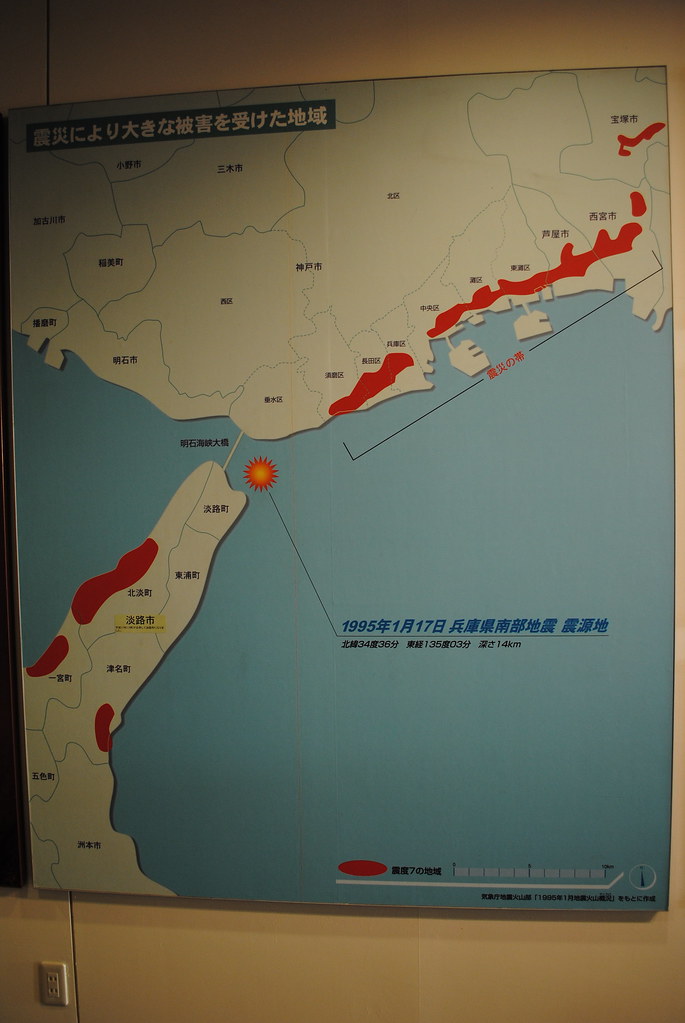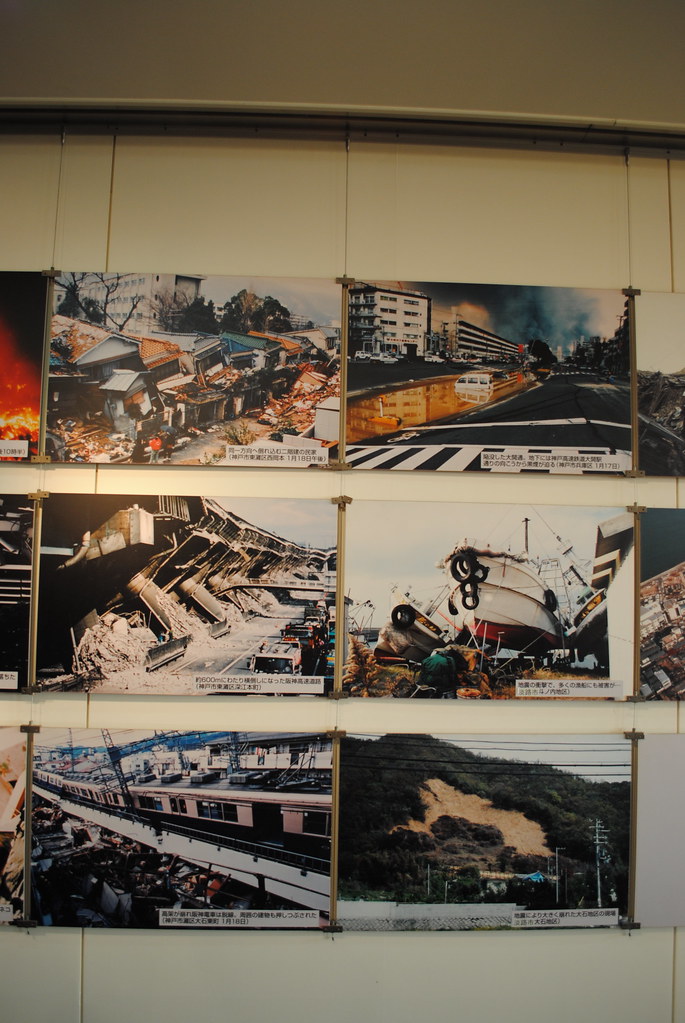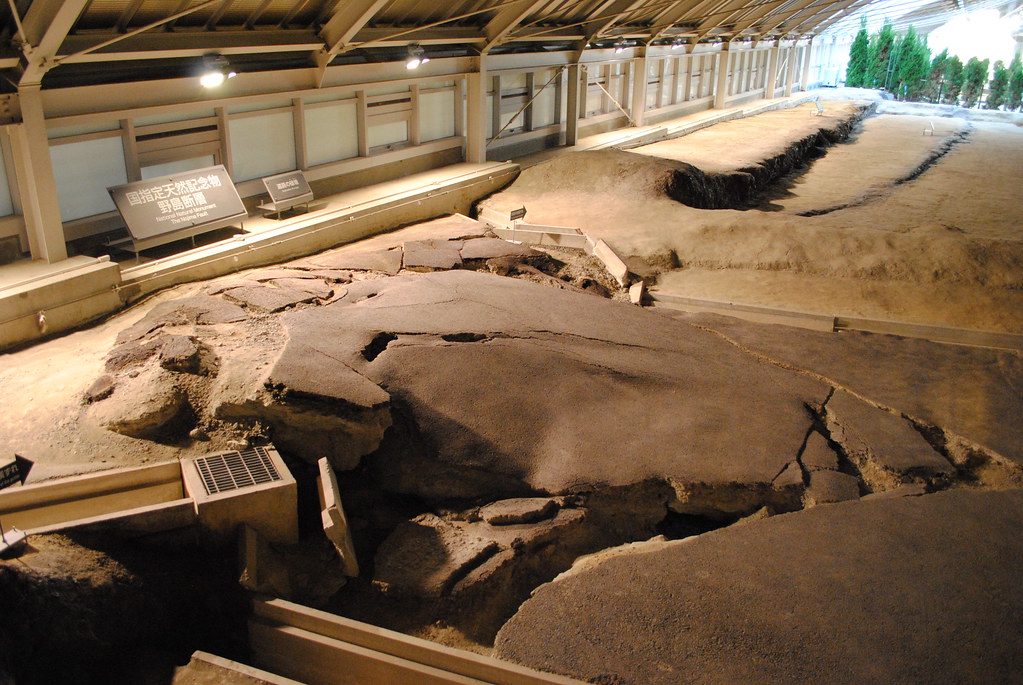The recent events in Japan with the 東北 (とうほく - Touhoku) 地震 (じしん - jishin - earthquake) come as another tragic reminder of the devastation that can be caused by natural disasters. Being one of the most 地震-prone countries in the world, Japan is shaken by hundreds of tremors every year and unfortunately, some are orders of magnitude worse than the usual cupboard-rattling shake. In the face of all the destruction, I think the resilience and ingenuity of the Japanese people is to be admired; early warning signals, 地震-resistant buildings and a rapid response to the crisis surely all played a part in minimising the losses. You don't need to look too far to see where all the experience came from - in 1995, the 阪神淡路大震災 became one of the most infamous chapters in the history of 神戸 (こうべ - Kobe) and formed the basis for future 地震 response across Japan.
The 阪神淡路大震災 is so named because its epicentre was extremely close to 淡路島 (あわじしま - Awajishima - Awaji Island) and impacted the entire 阪神 (はんしん - Hanshin) area, which encompasses 神戸, 大阪 (おおさか - Osaka) and several smaller cities between them. It's also referred to as the "Awaji Earthquake", the "Hanshin Earthquake" and the "Kobe Earthquake" for this reason, but there's no disagreement on the level of devastation. It struck in the early morning of January 17th, 1995, measuring a 7 on the Japanese Meteorological Scale, the maximum level.
Although the 地震 itself only lasted a short time, the damage was catastrophic. Many of the buildings and infrastructure in 神戸 had not been built to withstand forces of this level; trains were derailed, large sections of the 阪神 expressway collapsed, buildings toppled across the capital and gas explosions set many wooden structures alight. I'm told that having big heavy roof-tiles was a sign of affluence at the time but tragically, their added weight crushed many homes already weakened by the disaster adding further casualties. Over 6000 lives were lost in the disaster, but it can be considered a small mercy that it happened so early in the morning; had the worst of the 地震 struck during rush hour, the losses would have been far greater.
The faultline responsible for the 阪神淡路大震災 is called the 野島断層 (のじまだんそう - nojima dansou - Nojima Fault), which runs underneath 淡路. This forms the foundation for perhaps the most famous 地震 museum where its full effects can be seen. It was effectively built to enclose one of the worst affected areas along the 野島断層, with the broken roads and buckled earth preserved as they were at the time of the disaster. The museum features scale models and demonstrations of what actually happened, but it's much more striking to see the results for yourself.
A large piece of the ground has been cut away to show a cross section of the 野島断層, which thrust up an entire section of earth and rock into a ridge more than a metre higher than the original ground level. This ridge stretches along the entire section of preserved soil creating two very distinct levels in the ground, so it's not hard to imagine how the damage was so prodigious. Looking at the partly liquefied rock from where the two surfaces ground together certainly gives some idea of just how much power was involved in those few seconds.
There is also a "地震 experience room", which features a mock-up living room that you can sit in for simulations of the main quake and aftershocks. At the time I found myself a bit underwhelmed by the tremor, but having since experienced an actual 地震 in my area I've truly come to appreciate how terrifying it must have been. The advantage of a simulation is that it stops and you can get off, but when the real thing hits it's quite genuinely one of the scariest things you can experience. As far as my brain and heart are concerned, 地震 simulators and rollercoasters can shake to their hearts' content, the ground and large apartment buildings should stay perfectly still.
Having taken most of the damage from the disaster, 神戸 has several 阪神淡路大震災 monuments and memorials. Firstly, one section of ハーバーランド (haabaarando - Harbourland) called メリケンパーク (meriken paaku - (A)Merican Park) has preserved a broken section of ground, complete with wonky streetlights, as a reminder of the damage. This isn't the only scar 神戸 bears - although you might not realise it just by visiting, it has never truly recovered its reputation as the busiest port in Japan. The cleanup and rebuilding took a huge amount of time and many people criticised the sluggish response. One of my coworkers gravely remembers taking what she could carry and joining the crowds on an eight hour walk to the relative safety of 明石 (あかし - Akashi), where they had a better chance of being taken care of. Since then, disaster centres have been set up across 兵庫 (ひょうご - Hyogo) and the anniversary of the 阪神淡路大震災 kicks off "disaster awareness week", during which they encourage 地震 safety training and maintenance of early-warning systems.
Finally, in December every year, one of the biggest festivals in the city is the 神戸ルミナリエ (Kobe Luminarie), a week-long lightup to commemorate the disaster. Several main streets around 神戸 are closed off to cars and dozens of huge archways of lights are erected for people to walk through and enjoy. It's clear 神戸 hasn't forgotten the lessons of its past, in form and function; Japanese buildings and infrastructure are now built to flex and withstand tremors, 地震 warnings flash on television stations and 携帯電話 (けいたいでんわ - keitai denwa - mobile phones) at a moment's notice and both the public and the professionals are well trained and informed on how to deal with a crisis quickly and effectively. Experience is the best teacher and in this case the cruelest I can think of, but even in the face of the recent devastation, I can't imagine being in safer hands.
I'm sure you'll join me in wishing the people of 東北 a speedy recovery and a safe and prosperous future, no matter what comes next.







No comments:
Post a Comment
If you have any questions or additions, I would love to hear from you. I may not know the answer, but I'll do my best to find out in any case! You can post anonymously if you like, but abusive/unintelligible/inappropriate comments will not be published.